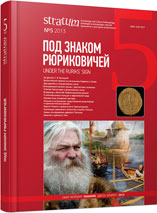Отражение этапов развития Тихвинского Большого Успенского монастыря в материалах археологических исследований 2010 г.
The Reflection of Stages of Development of the Tikhvin Bolshoy Uspensky Monastery in Materials of Archaeological Research in 2010
Author(s): Svetlana E. ShunginaSubject(s): History, Archaeology, Middle Ages, Modern Age, 6th to 12th Centuries, 13th to 14th Centuries, 15th Century, 16th Century, 17th Century, 18th Century, 19th Century
Published by: Издательский дом Stratum, Университет «Высшая антропологическая школа»
Keywords: Tikhvin; Leningrad region; 12th—20th centuries; Bolshoy Uspensky Monastery; Zhitennye (barn) cells; archaeological research; stone foundation; monastery cemetery; pre-monastery settlement; ceramic col
Summary/Abstract: The article presents archaeological research of trench VII on the area of 122.5 square meters within the boundaries of the Bolshoy Uspensky Monastery in Tikhvin. Disclosed were undisturbed cultural layers, the earliest of which date back to existence of Pretchistensky churchyard. The researchers examined graves of the monastic cemetery (65 graves dated by 18th—19th cc.) in the western part of the trench and defined its eastern border. In the central part of the trench, a fragment of the foundation of the western wall of the Zhitennye cells (barn cells) (this part of the building was disassembled) and foundation trench for the eastern wall of the cells were examined.As a result, we have identified main stages in development of the site, which are confirmed by written sources. First stage (12th—14th centuries) — primary population of this territory; second stage (15th — middle of 16th century) — the settlement prior to construction of the monastery; third stage (second half of 16th — 17th century) — reclaiming of territory by the monastery, construction of the wooden Zhitennye (“barn”) monastic cells; fourth stage (turn of 17th/18th — early 19th century) — stone construction, functioning of the monastic cemetery; fifth stage (middle — second half of the 20th century) — “civil” use of the monastery’s territory. Collection of ceramic material and individual findings can quite accurately date the stratigraphy.
Journal: Stratum plus. Археология и культурная антропология
- Issue Year: 2013
- Issue No: 5
- Page Range: 121-130
- Page Count: 10
- Language: Russian
- Content File-PDF

